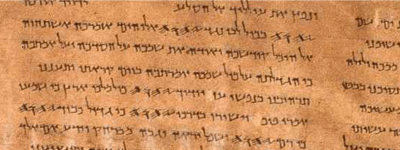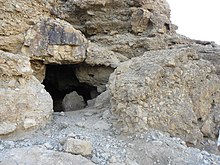Great scroll of psalms
The Great Scroll of Psalms from Qumran ( 11Q5 or 11QPs a ) is a parchment scroll that was written about between AD 30 and 50. It contains 40 biblical psalms as well as eight other texts in the Hebrew language .
The roll is 4.253 meters long, incomplete and made of dark yellow leather. The divine name YHWH is written in ancient Hebrew script . The scroll and the fragments later assigned to it are now in the Israel Museum in Jerusalem .
Discovery
At the beginning of February 1956 Bedouins found the role later named in the edition of James A. Sanders 11QPs a in cave 11. This location is confirmed by 4 fragments (A, B, C, D), which were subsequently discovered during a scientific excavation: the same Writer's hand, same material, same content. The Bedouins gave the role to the Palestine Archaeological Museum ( Rockefeller Museum ), where it remained unopened until 1961.
It was opened and unrolled in November 1961 under the direction of Sanders. At the turn of the year 1961/62 it became known that there was another fragment E that had been in the possession of Yigael Yadin . This closed a larger gap at the beginning of the role.
State of preservation
The roll consisted of 7 leather bows and was originally estimated to be between 5.30 and 5.60 m long and about 26 cm high. A continuous strip of 15-18 cm with the upper edge of the roll is preserved, while the lower part is completely rotten and thus lost.
If one does not want to assume that the damage to the roll can be traced back to the improper handling and storage by the Bedouins before they handed over their find to the museum, the following (more likely) scenario explains the condition of the roll:
- The relatively tightly wound roll stood upright in the cave for centuries. Gradually, moisture coming from below destroyed the lower third.
- The role lost its stability and fell over. A piece about 1.50 m long rolled off the roll. This unwound first part of the scroll went through a different process of destruction than the part that was still rolled up. In the latter, the rotting progressed inward from the contact surface on the floor.
content
The psalms are arranged in a different order than in the masoretic text :
Psalm 101 → Psalm 102 → Psalm 103 → Psalm 109 [110] → Psalm 118 → Psalm 104 → Psalm 147 → Psalm 105 → Psalm 146 → Psalm 148 [+ Psalm 120 ] → Psalm 121 → Psalm 122 → Psalm 123 → Psalm 124 → Psalm 125 → Psalm 126 → Psalm 127 → Psalm 128 → Psalm 129 → Psalm 130 → Psalm 131 → Psalm 132 → Psalm 119 → Psalm 135 → Psalm 136 → Doxology → Psalm 145 [with additional verse between the individual verses] → Psalm 154 → Plea for Deliverance → Psalm 139 → Psalm 137 → Psalm 138 → Sir 51: 13-30 EU → Apostrophe to Zion → Psalm 93 → Psalm 141 → Psalm 133 → Psalm 144 → Psalm 155 → Psalm 142 → Psalm 143 → Psalm 149 → Psalm 150 → Hymn to the Creator → 2 Sam 23.1–7 EU → David's Compositions → Psalm 140 → Psalm 134 → Psalm 151 A → Psalm 151 B, empty column.
11QPs a contains new, previously unknown psalms. The edition did not receive any numbers, but the following English titles:
- Plea for Deliverance (“Request for Redemption”);
- Apostrophe to Zion ("invocation of Zion");
- Hymn to the Creator ("Hymn to the Creator");
- David's Compositions ("Compositions of David").
Apostrophe to Zion is transmitted in other Qumran scrolls with psalm texts: in 4Q88 and probably also 11QPs b (fragment 6).
The doxology between Psalm 136 and Psalm 145 is a self-contained prayer of thanksgiving and praise compiled from verses from Psalm 136 and Psalm 118.
This arrangement poses a number of questions: Was the formation of the book of Psalms in the order we use today already completed at this point in time or was it still in the making? Did the scribes change the canonical order themselves or did it not exist at the time?
Ulrich Dahmen advocates the following thesis: "From its text form, 11QPs a proves to be a Qumranian product, as independent, unique and as a whole arranged according to the MT text form." He dates the text form (to be distinguished from the age of the specific role) in the 2nd Half of the 2nd century BC The assumption that the Qumran community used this composition liturgically, "and wanted to 'invoke' the Davidic Messiah with it," is neither demonstrable nor refutable. "It is a matter of a" functional composition completely detached from the Psalter as a book. " .
Daniel Stökl Ben Ezra , on the other hand, believes that at the time the scroll was written, in the middle of the 1st century AD, neither the discussion of which poems belonged to the Book of Psalms had been completed, nor the content and order of the last part of today's (Biblical) book of psalms were fixed.
literature
- James A. Sanders: The Psalms Scroll of Qumrân Cave 11 (11QPs a ) (= Discoveries in the Judean Desert of Jordan . Volume 4). Clarendon Press, Oxford 1965.
- Ulrich Dahmen: Psalms and Psalter Reception in Early Judaism. Reconstruction, text inventory, structure and pragmatics of the psalm roll 11QPsa from Qumran (= Studies on the texts of the desert of Judah. Volume 49). Brill, Leiden u. a. 2003. ISBN 90-04-13226-0 .
- Géza G. Xeravits, Peter Porzig: Introduction to the Qumran literature. Walter de Gruyter, Berlin / Boston 2015, p. 219 f. ( online , with literature).
- William Yarchin: Were the Psalms Collections at Qumran True Psalters? In: Journal of Biblical Literature 4/2015, pp. 775-789. ( PDF )
- Daniel Stökl Ben Ezra: Qumran. The Dead Sea Texts and Ancient Judaism . Mohr Siebeck, Tübingen 2016. ISBN 978-3-8252-4681-5 .
Web links
- Israel Antiquities Authority , The Leon Levy Dead Sea Scrolls Digital Library: 11QPsalms a
Individual evidence
- ^ Daniel Stökl Ben Ezra: Qumran , Tübingen 2016, p. 124 f.
- ↑ a b c Ulrich Dahmen: Psalms and Psalter Reception in Early Judaism , Leiden 2003, p. 25.
- ↑ Ulrich Dahmen: Psalms and Psalter Reception in Early Judaism , Leiden 2003, p. 32 f.
- ^ Daniel Stökl Ben Ezra: Qumran , Tübingen 2016, p. 206.
- ^ Karl-Heinrich Ostmeyer: Jewish prayers from the environment of the New Testament , Leuven 2019, 34–37 (with German translation).
- ↑ Ulrich Dahmen: Psalms and Psalter Reception in Early Judaism , Leiden 2003, p. 313.
- ↑ Ulrich Dahmen: Psalms and Psalter Reception in Early Judaism , Leiden 2003, p. 314.
- ↑ Ulrich Dahmen: Psalms and Psalter Reception in Early Judaism , Leiden 2003, p. 315.
- ↑ Ulrich Dahmen: Psalms and Psalter Reception in Early Judaism , Leiden 2003, p. 316.
- ^ Daniel Stökl Ben Ezra: Qumran , Tübingen 2016, p. 206 f.


